<< Previous | Displaying results 3151-3175 of 6772 for "" | Next >>
A Jewish New Year greeting card from Hela Brett, the donor's friend. In the winter of 1945-46, Rochelle Shulman (born Rochelle Szklarski), her father, and sisters left Poland with the help of the Brihah. They reached the Bad Reichenhall displaced persons camp and stayed there until February 1949, when they sailed to New York aboard the SS Marine Shark. Bad Reichenhall, Germany, September 1947.
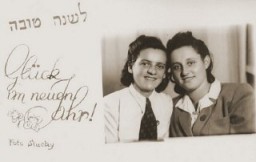
A pair of shoes left behind after a deportation action in the Kovno ghetto. Photographer George Kadish captioned the photo "The body is gone." Kovno, Lithuania, circa 1943.
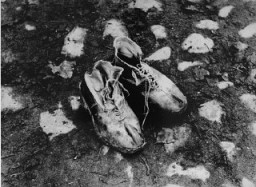
A young boy holding his younger brother in the Kovno ghetto. Older children frequently cared for younger siblings in the ghetto. Photographed by George Kadish. Kovno, Lithuania, 1941.
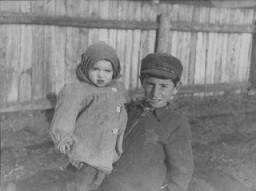
Soviet officers preside over the opening and exhumation of a mass grave at the Ninth Fort. Photographed by George Kadish. Kovno, Lithuania, 1944.
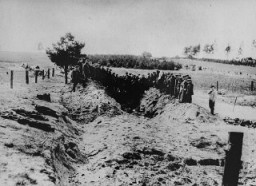
Secretary of the Kovno ghetto Jewish council Avraham Tory stands with Zvi Brik (left), workshop administrator, in the cemetery of the Kovno ghetto. Kovno, Lithuania, 1943.
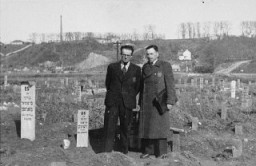
Prewar studio portrait in Sighet of Jewish siblings Suri and Ari Deutsch, both of whom died in the Holocaust. This photograph comes from the album of their cousin, Rosalia Dratler Roiter. Rosalia was deported to and died at Auschwitz. Sighet, Romania, 1937.
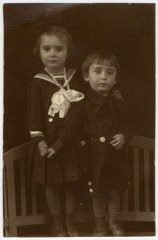
A group of young boys pose on and next to the demolished vehicle of local Jewish teacher Ferdinand Stern. The car had been driven to a nearby lake and set on fire during Kristallnacht. Frankenberg, Germany, November 1938.
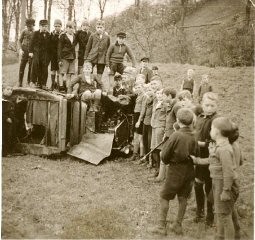
A Lithuanian auxiliary policeman auctions off property owned by persons killed in SS-managed shooting operations. Lithuanian auxiliaries served as shooters and guards in these operations. Were those who bought the clothing, who likely knew some of the victims in this small town, complicit in the crimes? Utena, Lithuania, July–August 1941.
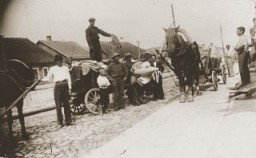
Hungarian Zionist leaders Otto Komoly and Rezso Kasztner (left), who negotiated with the SS for the release of Jews from Hungary. Budapest, Hungary, 1944.
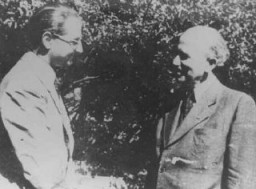
Jews from the "Kasztner train" arrive in Switzerland. This group of Jews was released from Bergen-Belsen as a result of negotiations between the Germans and Hungarian Jewish leaders Joel Brand and Rezso Kasztner. Switzerland, August 1944.
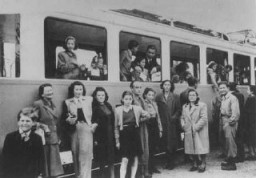
George Mandel-Mantello greets the Satmar Rebbe, Joel Teitelbaum, upon his arrival in Switzerland on the Kasztner transport from Bergen-Belsen. Switzerland, December 1944.
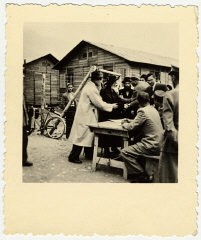
Commemorative postcard with a drawing of barrack 11 of Bergen-Belsen and marking the time the people on the Kasztner train spent in the camp. The Jews from the Kasztner transport lived in two barracks, 10 and 11, inside Bergen-Belsen. (This was probably drawn by the Hungarian artist Robert (Imre) Irsay who himself was on the Kasztner transport.)
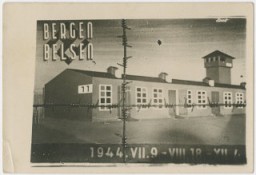
Aluminum food container lid used by a Hungarian Jewish family on the Kasztner train. The family had used the container on outings outside Budapest. It later accompanied them to Bergen-Belsen, Switzerland and, finally, to the United States.
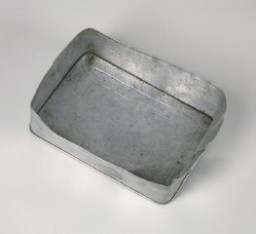
Soviet leader Joseph Stalin (left), US president Franklin D. Roosevelt (center), and British prime minister Winston S. Churchill (right) at the Tehran Conference. Tehran, Iran, between November 28 and December 1, 1943.
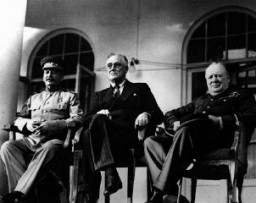
German Jewish adults and children wearing compulsory Jewish badges are lined up against a building. Weser, Germany, 1941–43.

Elsa Eisner, marked with a Jewish badge, walks down a street in Prague. She, her mother, twin sister and other members of the family were deported to Auschwitz in July 1942. Prague, Czechoslovakia, ca. 1941.
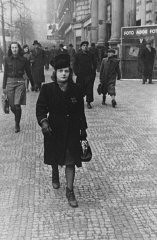
Portrait of an elderly Jewish woman wearing a Jewish badge in the Olkusz ghetto. Olkusz , Poland, 1941.
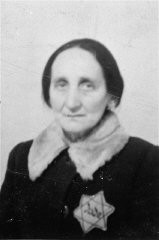
Jewish children wearing the compulsory yellow badge. In September 1943, they were deported to Auschwitz.Antwerp, Belgium, 1943.
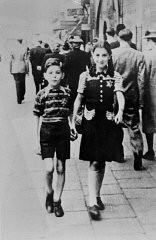
The Margules children wearing Jewish badges. Originally from Warsaw, the Margules family settled in Paris in the 1930s. Three of the children were deported and killed in 1942. Only one daughter (pictured at the bottom right) survived the war. Paris, France, 1941.
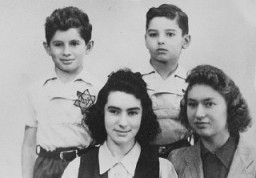
In the Jewish quarter of Paris, a Jewish woman wearing the compulsory Jewish badge stands at the entrance to a kosher butcher shop. France, between May 1942 and 1944.
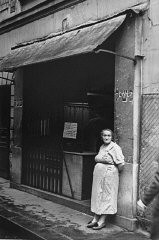
Portrait of the Weidenfeld family wearing Jewish badges in the Czernowitz (Cernauti) ghetto shortly before their deportation to Transnistria. Pictured from left to right are Yetty, Meshulem-Ber, Sallie, and Simche Weidenfeld. Cernauti, Romania, October 1941.
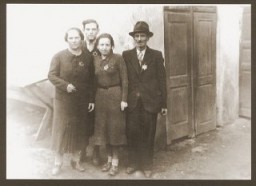
An elderly Jewish woman wears the compulsory yellow badge in the Riga ghetto. Latvia, between 1941 and 1944.
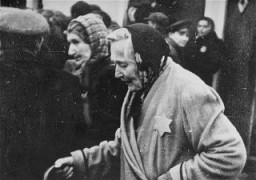
President Franklin D. Roosevelt sits with Eleanor Roosevelt in his study in the White House. FDR was elected the 32nd president of the United States in the presidential elections of November 1932. Washington, DC, 1933.
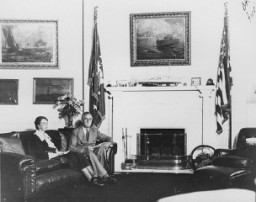
These Jewish children from the Children's Aid Society (OSE) home in Izieu were arrested and deported on the orders of Lyon Gestapo chief Klaus Barbie—the "Butcher of Lyon." France, 1944.
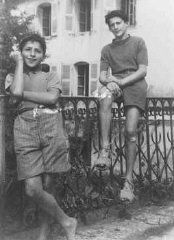
Lidice in smoke. The Nazis destroyed the Czech village in reprisal for the assassination by Czech resistance fighters of Reinhard Heydrich. Czechoslovakia, June 1942.

We would like to thank Crown Family Philanthropies, Abe and Ida Cooper Foundation, the Claims Conference, EVZ, and BMF for supporting the ongoing work to create content and resources for the Holocaust Encyclopedia. View the list of donor acknowledgement.